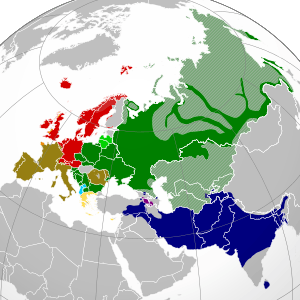Indo-Iranian languages
| Indo-Iranian | |
|---|---|
| Aryan | |
| Geographic distribution: | South, Central, and Western Asia |
| Linguistic classification: |
|
| Proto-language: | Proto-Indo-Iranian |
| Subdivisions: | |
| ISO 639-5: | iir |
| Glottolog: | indo1320[1] |
|
The approximate present-day distribution of the Indo-European branches of Eurasia:
Indo-Iranian | |
The Indo-Iranian languages or Indo-Iranic languages,[2][3] or just Aryan languages,[4] constitute the largest and easternmost extant branch of the Indo-European language family. It has more than 1 billion speakers, stretching from the Caucasus (Ossetian) and the Balkans (Romani) eastward to Xinjiang (Sarikoli) and Assam (Assamese), and south to the Maldives (Maldivian).
The common ancestor of all of the languages in this family is called Proto-Indo-Iranian—also known as Common Aryan—which was spoken in approximately the late 3rd millennium BC. The three branches of modern Indo-Iranian languages are Indo-Aryan, Iranian, and Nuristani. Additionally, sometimes a fourth independent branch, Dardic, is posited, but recent scholarship in general places Dardic languages as archaic members of the Indo-Aryan branch.[5]
Languages
Indo-Iranian consists of three groups:
Most of the largest languages (in terms of native speakers) are a part of the Indo-Aryan group: Hindustani (Hindi–Urdu, ~590 million[6]), Bengali (205 million[7]), Punjabi (100 million), Marathi (75 million), Gujarati (50 million), Bhojpuri (40 million), Awadhi (40 million), Maithili (35 million), Odia (35 million), Marwari (30 million), Sindhi (25 million), Rajasthani (20 million), Chhattisgarhi (18 million), Assamese (15 million), Sinhalese (16 million), Nepali (17 million), and Rangpuri (rajbanshi) (15 million). Among the Iranian branch, major languages are Persian (60 million), Pashto (ca. 50 million), Kurdish (35 million),[8] and Balochi (8 million). Numerous smaller languages exist.
History

The Indo-Iranian languages derive from a reconstructed common proto-language, called Proto-Indo-Iranian.
The oldest attested Indo-Iranian languages are Vedic Sanskrit (ancient Indo-Aryan), Older and Younger Avestan and Old Persian (ancient Iranian languages). A few words from another Indo-Aryan language (see Indo-Aryan superstrate in Mitanni) are attested in documents from the ancient Mitanni kingdom in northern Mesopotamia and Syria and the Hittite kingdom in Anatolia.
Features
Innovations shared with other languages affected by the satem sound changes include:
- Fronting and assibilation of the Proto-Indo-European (PIE) palato-velar stops: *ḱ, *ǵʰ, *ǵ > *ĉ, *ĵʰ, *ĵ
- The merger of the PIE labiovelar and plain velar stops: *kʷ, *gʷʰ, *gʷ > *k, *gʰ, *g
- The Ruki sound law
Innovations shared with Greek include:
- The vocalization of the PIE syllabic nasals *m̥, *n̥ to *a
- Grassmann's law
Innovations unique to Indo-Iranian include:
- The lowering of PIE *e to *a
- *o was also lowered to *a, though this occurred in several other Indo-European languages as well.
- Brugmann's law
References
- ↑ Hammarström, Harald; Forkel, Robert; Haspelmath, Martin; Bank, Sebastian, eds. (2016). "Indo-Iranian". Glottolog 2.7. Jena: Max Planck Institute for the Science of Human History.
- ↑ Mahulkar, D. D. Pre-Pāṇinian Linguistic Studies.
- ↑ Puglielli, Annarita; Mara Frascarelli. Linguistic Analysis: From Data to Theory.
- ↑ Džoj I. Edelman (1999). "On the history of non-decimal systems and their elements of Aryan languages". In Jadranka Gvozdanović. Numeral Types and Changes Worldwide. Walter de Gruyter. p. 221. ISBN 9783110161137. Retrieved 2013-01-02.
- ↑ Bashir, Elena (2007). Jain, Danesh; Cardona, George, eds. The Indo-Aryan languages. p. 905. ISBN 978-0415772945.
'Dardic' is a geographic cover term for those Northwest Indo-Aryan languages which [..] developed new characteristics different from the IA languages of the Indo-Gangetic plain. Although the Dardic and Nuristani (previously 'Kafiri') languages were formerly grouped together, Morgenstierne (1965) has established that the Dardic languages are Indo-Aryan, and that the Nuristani languages constitute a separate subgroup of Indo-Iranian.
- ↑ Edwards, Viv. "Urdu/Hindi Today". BBC.
- ↑ Thompson, Irene. "Bengali". AboutWorldLanguages. Retrieved March 29, 2013.
- ↑ CIA- The World Factbook: 14.7 million in Turkey (18%), 4.9–6.5 million in Iraq (15-20%), 8 million in Iran (10%) (all for 2014), plus several million in Syria, neighboring countries, and the diaspora
Sources
- Chakrabarti, Byomkes (1994). A comparative study of Santali and Bengali. Calcutta: K.P. Bagchi & Co. ISBN 81-7074-128-9
- Nicholas Sims-Williams, ed. (2002). Indo-Iranian Languages and Peoples. Oxford University Press.
External links
| Look up Indo-Iranian Swadesh lists in Wiktionary, the free dictionary. |
| Wikimedia Commons has media related to Indo-Iranian languages. |
- Swadesh lists of Indo-Iranian basic vocabulary words (from Wiktionary's Swadesh-list appendix)
